Stable Isotopes Laboratory
- Home
- Instruments and Personnel
- Methods and Applications
- Project and Scientific Interests
- Pubblications

The Stable Isotope Geochemistry Laboratory is a centre of excellence for advanced research on stable isotopes of hydrogen, carbon, nitrogen, and oxygen. With cutting-edge technological infrastructure and a multidisciplinary approach, the laboratory develops new analytical methods and applies innovative techniques to topics ranging from geology and environmental sciences to biology, archaeology, agronomy, and food sciences.
Stable isotope geochemistry: unravelling Earth processes
Stable isotope geochemistry allows us to study the natural mechanisms that control Earth System and biogeochemical cycles by using natural variations in isotope ratios. These studies are essential for:
- Reconstructing the origin and evolution of terrestrial fluids, such as hydrothermal, geothermal, and magmatic fluids, and understanding their role in geological processes.
- Advancing knowledge of geochemical cycles, with a particular focus on the carbon cycle—both surface and deep—and its evolution through time and space.
- Investigate interactions between the biosphere and the geosphere by identifying biotic and abiotic components in the formation and alteration of rocks and soils and in ecosystem dynamics.
- To provide critical data for understanding global and climate changes, and environmental processes over geological and recent timescales.
Technological innovation and cutting-edge research
The laboratory has pursued constant technological and scientific evolution, consolidating its commitment to frontier research. Its advanced instrumentation capable of performing high-resolution isotopic analyses, applicable to a wide range of scientific challenges.
In 2022, through the PNRR ITINERIS (Italian Integrated Environmental Research Infrastructures System) project, the laboratory was further upgraded with next-generation instrumentation, consolidating its position as one of the largest and most innovative centres for stable isotope studies in Italy and Europe. This investment in technological has expanded analytical capabilities and support increasingly ambitious research projects.
Open Science and International Networks
The Laboratory embraces the principles of Open Science, ensuring that scientific data are FAIR (Findable, Accessible, Interoperable, Reusable). This philosophy of openness and sharing is a key element of our research approach and enhances our global scientific impact.
The laboratory is an integral part of the European Plate Observing System (EPOS Link), a European network that integrates national research infrastructures dedicated to Solid Earth Sciences. EPOS promotes international collaboration and innovation to address the most complex scientific challenges.
We are also involved in the ITINERIS project (Link), funded by the European Union, which aims to create an integrated Italian system for the study of environmental processes in the atmosphere, ocean, terrestrial biosphere, and geosphere. As part of ITINERIS, the Laboratory is particularly focused on contributing to the development of a Virtual Research Environment (VRE) to share the scientific data and metadata produced within the Laboratory, according to the principles of FAIR.
Contact us
Our team is available for scientific collaborations and research projects. Do not hesitate to contact us to learn more about our work!
INSTRUMENTS
The laboratory’s facilities allow the measurement of both the content of total hydrogen, nitrogen, oxygen, organic and inorganic carbon (TN, H, TOC, TIC) in solid, liquid and gaseous samples and their isotopic composition.
The laboratory is currently involved in developing and implementing of new analytical methods to face research challenges that require improved analytical accuracy and precision.
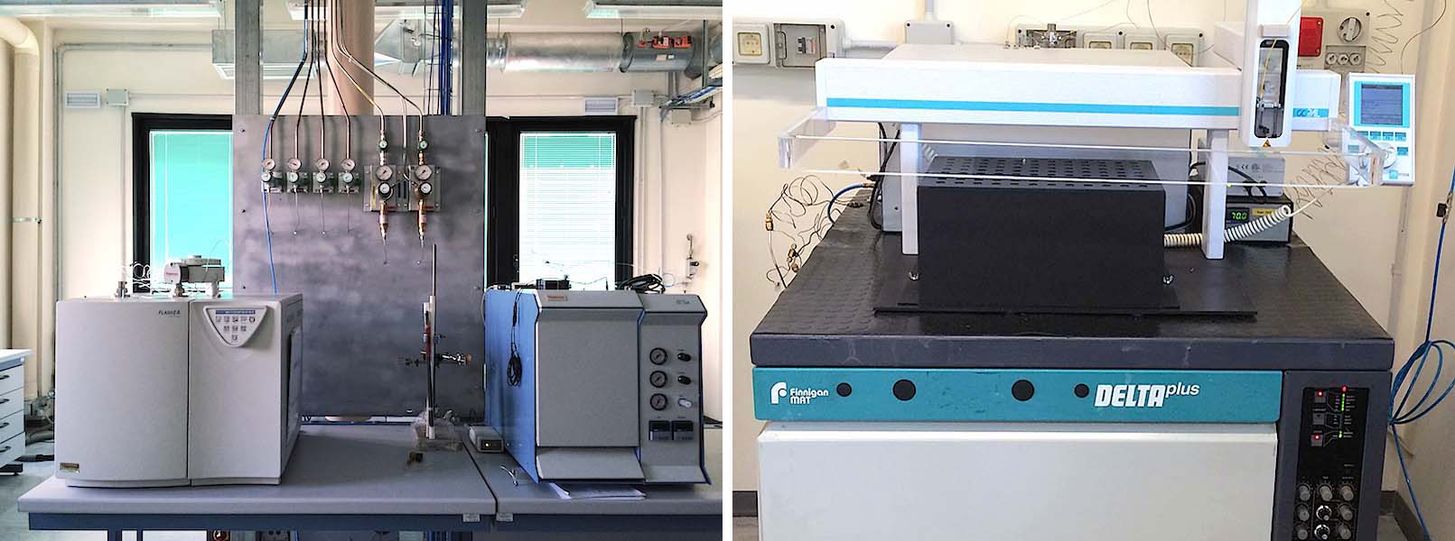
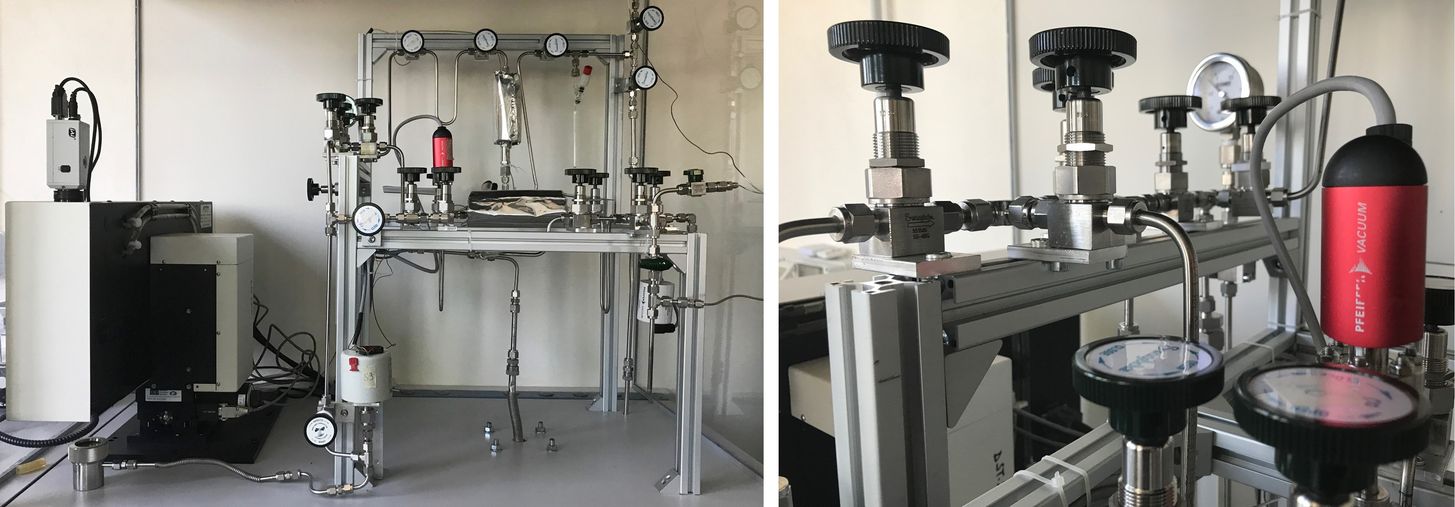
Four mass-spectrometers IRMS (Thermo Delta XP, Thermo Delta Adv, Finningan MAT Delta Plus, Finningan ThermoQuest Delta Plus) interface with:
- Laser - fluorination extraction line for the determination of 18O/16O ratios in silicates
- Gasbench II (Finningan) for the automated 18O/16O and 13C/12C ratios of carbonates and 13C/12C of TDIC
- Gas Chromatograph Trace GC Ultra (Thermo Scientific) for the separation of carbon compounds (CO2, hydrocarbons, biomarkers, etc) and for δ13C and, eventually, δ2H determination
- TC/EA (Finningan) for the oxygen and deuterium isotope analysis of solids
- Elemental Analyser Flash EA1112HT (Thermo Scientific) for the C, H, N, S, O elemental and isotope analysis of solids, liquids and gases (including head-space)
- Elemental Analyser (Carlo Erba) for the C, H, N elemental and isotope analysis of liquids (including cooking oil, wine, fuel oil, gasoline) and solids
- Automatic equilibration system for 18O/16O determination in water samples
- Off-line traditional vacuum preparation line for the extraction and clean up of CO2 for the 18O/16O and 13C/12C ratios determination from non-pure carbonates, rocks with variable (and low) carbonate content and carbonate mixtures (sequential extraction)
The laboratory is also equipped with an instrument (IRIS-Delta Ray from ThermoFischer Scientific) for the determination of CO2 concentration and carbon and oxygen isotopic composition by laser technology. The instrument has the enormous advantage that it can be used directly in-situ and for continuous analysis.
The figure shows different instrumental configurations for several analytical and research needs.

STAFF
Ilaria Baneschi
Chiara Boschi
Alessandro Bragagni
Abimbola Chris Ogunyele
Lisa Ricci
Andrea Rielli
The laboratory usually hosts colleagues, associates and trainees from Italian and foreign universities and research centers.
CONTACTS
Phone:
+39 050 621 2315 (Dr. Chiara Boschi)
+39 050 6212343 (Dr. Ilaria Baneschi)
E-mail:
chiara.boschi(at)igg.cnr(dot)it
The analytical techniques of the Stable Isotope Lab are multiple and depending on the matrix and the isotope to be analyzed. In particular, the sample must be adequately treated in order to obtain a gaseous aliquot to be introduced into the IRMS spectrometer in a continuous flow or manual (dual inlet).
Solid samples can be ablated (by laser extraction), combusted (by flash oxidation), pyrolyzed (by high temperature thermal decomposition), dissolved in acid or treated by organic solvents. Gaseous samples if pure (only N2, CO2, H2, CO) are injected as is, or separated cryogenically or by gas chromatographic techniques.
Examples of matrices, isotopic analyses, and applied research are listed below:
- Matrix: soils/sediments, vegetation, animal tissues, atmospheric and dissolved water particulates
- Isotopic ratio: 13C/12C, 15N/14N
- Applications: tracing and sources partitioning in environmental studies; studies of spatial and temporal variation in present and past environments; carbon dynamics in terrestrial ecosystems; trophic chain studies; paleo-diet studies; plant physiology; studies of biochemical processes.
- Matrix: solid and dissolved carbonates in water (DIC).
- Isotopic ratio: 13C/12C, 18O/16O
- Applications: hydrothermal, metamorphic and geothermal studies of inorganic carbonates in active and fossil systems; paleoclimatic and paleoenvironmental studies; hydrogeological studies and surface and groundwater dynamics (C in DIC); applications to cultural heritage.
- Matrix: silicate minerals and oxides (anhydrous and hydrates).
- Isotopic ratio: 2H/1H, 18O/16O
- Applications: petrological, geothermal, volcanological studies for mineral genesis and alteration dynamics.
- Matrix: dry and dissolved gases in water
- Isotopic ratio: 13C/12C
- Applications: volcanological and geothermal studies on CO2 and CH4; studies of biogas production dynamics; tracking of organic molecules; tracking of gas emissions and their reaction.
The lab develops new protocols, analytical techniques, and ad hoc applications in response to new research issues and challenges.
The table summarizes the isotope ratios analyzed by matrix type, precision, and minimum amounts required. Minimum analyzable aliquots must contain at least 5-20 micromoles of N and/or 10-200 micromoles of C for a single analysis. The material available for analysis must be 5 times the minimum analyzable amount, homogenized and finely ground (<150 mm). For silicate, oxide, and mineral hydrate d18O and d 2H analyses separate minerals are required.
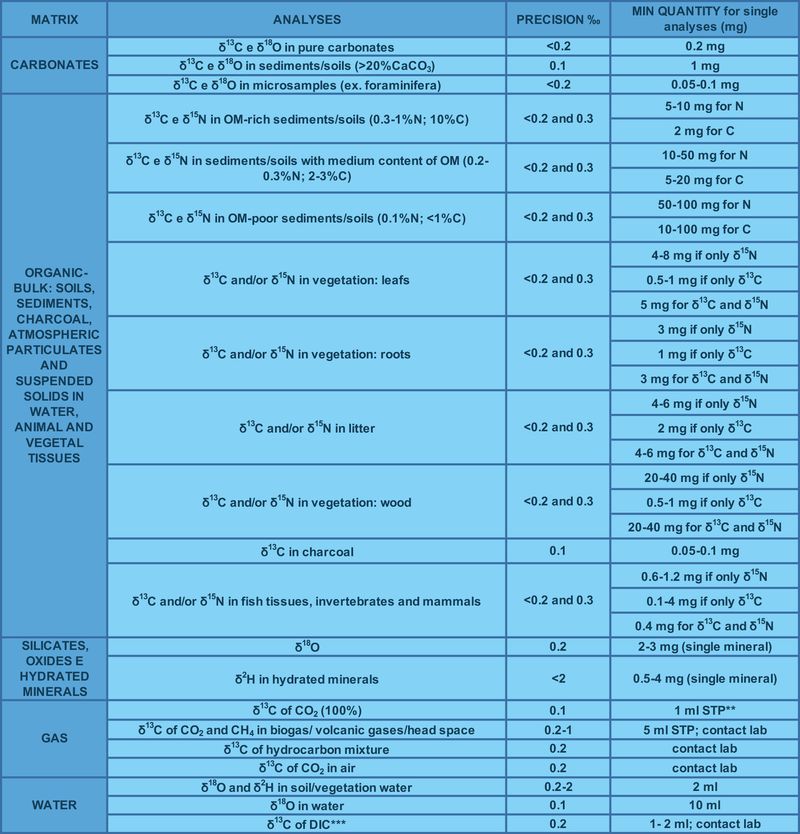
PROJECTS
Project ITINERIS 2022-2025 (Next Generation EU PNRR) “Italian Integrated Environmental Research Infrastructures System” Link
Project NHEAT 2023-2025 (PRIN-PNRR 2022) “Natural Hydrogen for Energy trAnsiTion” Link
Project STORECO2 2023-2025 (PRIN-PNRR 2022) “Advancing the STORagE of anthropogenic CO2 emissions by understanding natural carbonation systems” Link
Project Bilateral CNR Italy-South Korea 2024-2026
Project ICEtoFLUX 2022-2024 (PRA 2021) “HydrologIcal changes in ArctiC Environments and water-driven biogeochemical” Link
Project Abreso Belmont Forum 2021-2024 “ABandonment and REbound: SOcietal views on landscape- and land-use change and their impacts on water and soils” Link
Project GECO 2018-2023 (Horizon 2020) “Geothermal Emission Gas Control” Link
Project Ecopotential 2015-2019 (HORIZON 2020) “Improving future Ecosystem Benefits through earth observations” Link
IODP EXPEDITION 357 “Atlantis Massif Serpentinization and Life” Link
Project DESCRAMBLE 2015-2018 (Horizon 2020) “Developing the next generation technologies of renewable electricity and heating/cooling” Link
Project IMAGE 2013-2017 (FP7 Europe) “Integrated Methods for Advanced Geothermal Exploration” Link
The Ritmare Flagship Project 2012-2016 (MIUR) “Planning of the Deep Marine Environment and the Open Sea”
Project RESPIRA 2009-2013 (POR-FSE Tuscan Region) “Tuscan serpentinites reservoir: from potential pollutant to environmental resource”
RESEARCH HIGHLIGHTS
Fluid-rock interactions in oceanic settings: serpentinization and low-temperature alteration
Hydrothermal alteration processes in mafic and ultramafic systems and carbonation
Mineralogical sequestration of CO2 in mafic and ultramafic systems
Carbonate formation in different geodynamic environments
Mineral deposits
Geological hydrogen
Temperature formation of minerals in the Earth's crust
Carbon transport in terrestrial environments of polar and remote areas
Interactions between geo-, bio- and hydrosphere (lakes, wetlands, soils, permafrost) today and in the past for environmental and climatic reconstructions.
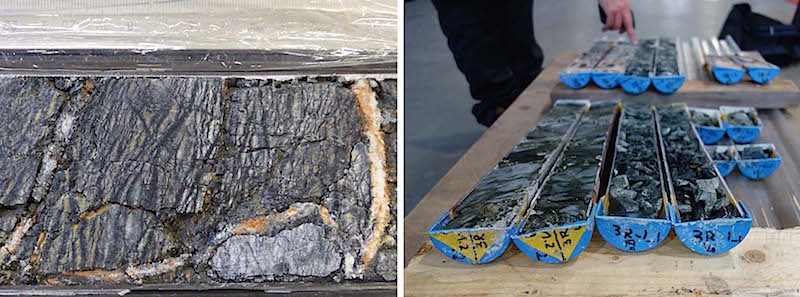

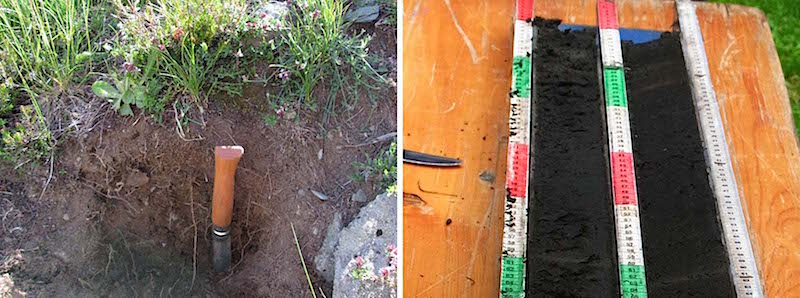
SELECTED PUBLICATIONS
Baneschi I, Giamberini M., Magnani M., Mosca P., Raco B., Vivaldo G., Provenzale A. (2024). Alpine Critical Zone Observations at the Gran Paradiso National Park, Italy. In T. White and A. Provenzale (eds.), Critical Zone and Ecosystem Dynamics, Advances in Critical Zone Science, Springer Nature Switzerland AG 2024.
Dini A., Rielli A., Di Giuseppe P., Ruggieri G., Boschi C. (2024). The Ophiolite-Hosted Cu-Zn VMS Deposits of Tuscany (Italy). Minerals 14 (3), 273.
Curzi M., Aldega L., Billi A., Boschi C., Carminati E., Vignaroli G., Viola G., Bernasconi S.M. (2024). Fossil chemical-physical (dis)equilibria between paleofluids and host rocks and their relationship to the seismic cycle and earthquakes. Earth-Science Reviews, 254, 104801.
Danise S., Giachetti G., Baneschi I, Casalini M., Miniati F., Dominici S., Boschi C. (2024). Sclerochronology of the large scallops Gigantopecten latissimus and Pecten jacobaeus in a Pliocene warmer Mediterranean Sea. Palaeogeography, Palaeoclimatology, Palaeoecology, 654, 112429.
Billi A., Smeraglia L., Aldega L., Balsamo F., Barberio M.D., Boschi C., Caracausi A., Carminati E., Iannace A., Mercuri M., Pizzati M., Tavani S. (2023). Dolostone pulverization induced by coseismic rapid decompression of CO2-rich gas in nature (Matese, Apennines, Italy). Earth and Planetary Science Letters, 604, 117996.
Chimenti M., Natali S., Giannecchini R., Zanchetta G., Baneschi I., Doveri M., Isola I., Piccini L. (2023). Hydrogeochemistry and Isotopic Composition of Waters in the Renella Cave (Central Italy): New Insights into Groundwater Dynamics. Water 2023, 15, 1764.
Malinverno E., Bosio G., Gioncada A., Cimò R., Andò S., Mariani L., Coletti G., Boschi C., Gariboldi K., Galimberti L., Bianucci G., Urbina M., Di Celma C. (2023). Laterally-continuous dolomite layers of the Miocene Pisco Formation (East Pisco Basin, Peru): a window into past cyclical changes of the diagenetic environment. Mar. Petrol. Geol., 147, 105977.
Rielli A., Boschi C., Dini A., 2022. Tectonically driven carbonation of serpentinite by mantle CO2: Genesis of the Castiglioncello magnesite deposit in the Ligurian ophiolite of central Tuscany (Italy), Ore geology review, 149,105022, doi.org/10.1016/j.oregeorev.2022.105022.
Baldanza A., Bizzarri R., Boschi C., Famiani F., Frondini F., Lezzerini M., Rowland S., Sutton P.A. (2022). CO2-Degassing Carbonate Conduits in Early Pleistocene Marine Clayey Deposits in Southwestern Umbria (Central Italy). Minerals, 12, 819.
Curzi M., Caracausi A., Rossetti F., Rabiee A., Billi A., Carminati E., Aldega L., Bernasconi S.M., Boschi C., Drivenes K., Rizzo A.L., Sørensen B.E. (2022). From Fossil to Active Hydrothermal Outflow in the Back-Arc of the Central Apennines (Zannone Island, Italy). Geochemistry, Geophysics, Geosystems, 23, e2022GC010474.
De Santis V., Cicala D., Baneschi I., Boschi C., Brignone S., Iaia M., Zaupa S., Volta P. (2022). Non-native fish assemblages display potential competitive advantages in two protected small and shallow lakes of northern Italy. Glob. Ecol. Conserv., 35, e02082.
Natali S., Doveri M., Giannecchini R., Baneschi I., Zanchetta G. (2022). Is the deuterium excess in precipitation a reliable tracer of moisture sources and water resources fate in the western Mediterranean? New insights from Apuan Alps (Italy). Journal of Hydrology, 614, 128497.
Zanchetta G., Baneschi I., Magny M., Sadori L., Termine R., Bini M., Vanniere B., Desmet M., Natali S., Luppichini M., Pasquetti F. (2022). Insight into summer drought in southern Italy: palaeohydrologicalevolution of Lake Pergusa (Sicily) in the last 6700 years. Quaternary Sci., Vol. 37(7) 1280–1293.
Boldrocchi G., Spanu D., Mazzoni M., Omar M., Baneschi I.. Boschi C., Zinzula L., Bettinetti R., Monticelli D. (2021). Bioaccumulation and biomagnification in elasmobranchs: a concurrent assessment of trophic transfer of trace elements in 12 species from the Indian Ocean. Mar. Pollut. Bull., 172, 112853.
Natali S., Baneschi I., Doveri M., Giannecchini R., Selmo E., Zanchetta G. (2021). Meteorological and geographical control on stable isotopic signature of precipitation in a western Mediterranean area (Tuscany, Italy): Disentangling a complex signal. Journal of Hydrology, 603, 126944.
Schwarzenbach E. M., Vogel M., Früh-Green G. L., Boschi C. (2021). Serpentinization, carbonation and metasomatism of ultramafic sequences in the Northern Apennine ophiolite (NW Italy). Journal of Geophysical Research: Solid Earth, 126, e2020JB020619. https://doi.org/10.1029/2020JB020619.
Curzi M., Bernasconi S., Billi A., Boschi C., Aldega L., Franchini S., Albert R., Gerdes A., Barberio M. D., Looser N., Carminati E., 2021. U-Pb age of the 2016 Amatrice earthquake causative fault (Mt. Gorzano, Italy) and paleo-fluid circulation during seismic cycles inferred from inter- and co-seismic calcite. Tectonophysics, 819, doi.org/10.1016/j.tecto.2021.229076
Smeraglia L., Aldega L., Bernasconi S., Billi A., Boschi C., Caracausi A., Carminati E., Franchini S., Rizzo A. L., Rossetti F., Vignaroli G., (2020). The role of trapped fluids during the development and deformation of a carbonate/shale intra-wedge tectonic mélange (Mt. Massico, Southern Apennines, Italy), Journal of Structural Geology, 138:104086, DOI: 10.1016/j.jsg.2020.104086.
Baneschi I., Magny M., Zanchetta G. 2020. “Are stable isotopes of lacustrine carbonate a good tracer of lake hydrology and lake level variability?”. Alpine and Mediterranean Quaternary 33 (1): 99-106.
Boschi, C., Bedini, F., Baneschi, I., Rielli, A., Baumgartner, L., Perchiazzi, N., Ulyanov, A., Zanchetta, G., Dini, A. (2020). Spontaneous Serpentine Carbonation Controlled by Underground Dynamic Microclimate at the Montecastelli Copper Mine, Italy. Minerals, 10, 1.
Boretto G., Zanchetta G., Consoloni I., Baneschi I., Guidi M., Isola I., Bini M., Ragaini L., Terrasi F., et al. (2020). Stable Oxygen and Carbon Isotope Composition of Holocene Mytilidae from the Camarones Coast (Chubut, Argentina): Palaeoceanographic Implications. Water, 12(12): 3464.
Curzi, M., Aldega, L., Bernasconi, S.M., Berra, F., Billi, A., Boschi, C., Franchini, S., Van der Lelij, R., Viola, G., Carminati, E., 2020. Architecture and evolution of an extensionally-inverted thrust (Mt. Tancia Thrust, Central Apennines): Geological, structural, geochemical, and K–Ar geochronological constraints, Journal of Structural Geology, 136, art. no. 104059. DOI: 10.1016/j.jsg.2020.104059.
Maino,M., Casini L., Boschi C., Di Giulio A., Setti M., Seno S. (2020). Time‐dependent heat budget of a thrust from geological records and numerical experiments. Journal of Geophysical Research: Solid Earth, 125, e2019JB018940.